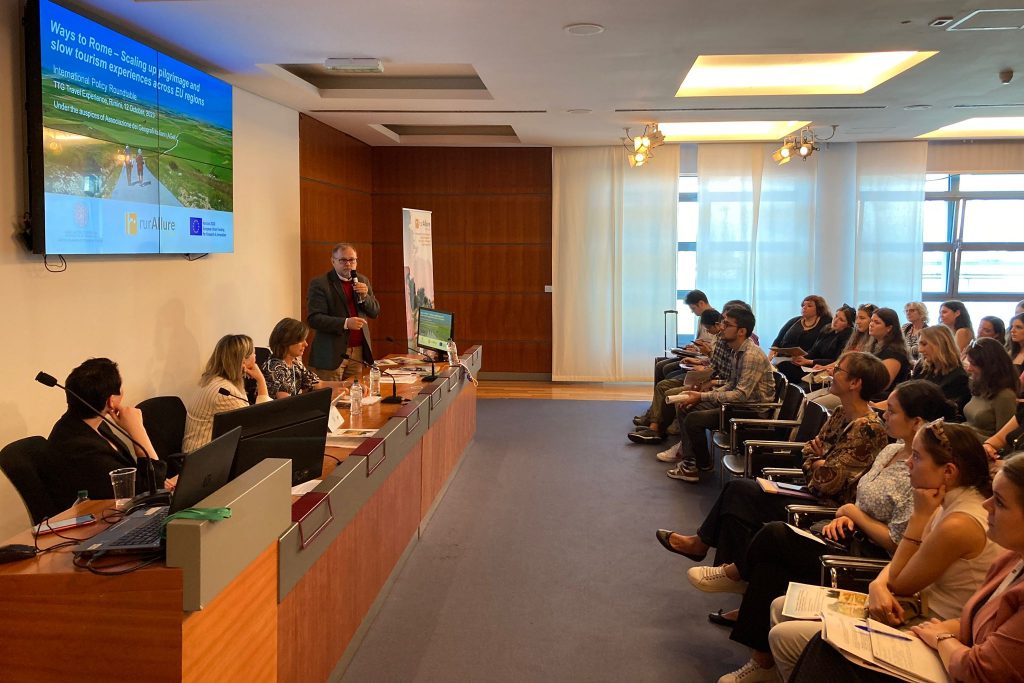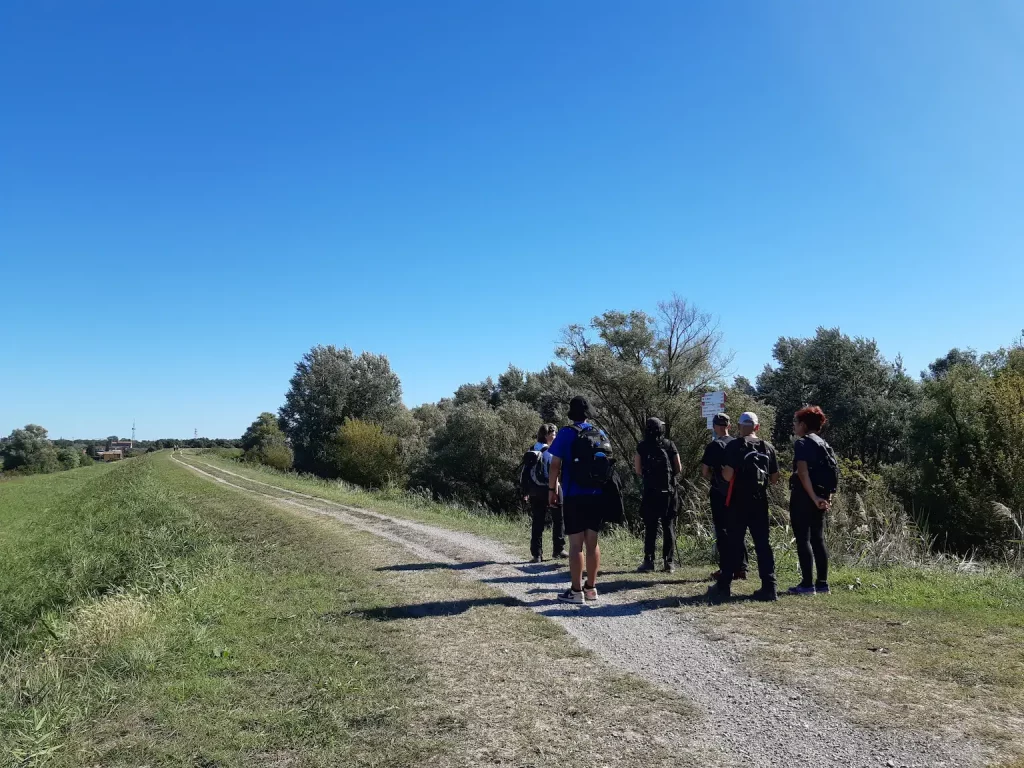The Role of Transnational Pilgrimage Routes in Territorial Governance: A PhD thesis research based on the rurAllure project
By Maria Laura Gasparini

European pilgrimages. Pixabay
Pilgrimage routes have experienced a global resurgence, attracting not only religious travellers but also those interested in slow and outdoor tourism. These routes provide opportunities to explore new places, engage with local communities, and appreciate cultural and natural heritage. As 90% of these routes pass through rural areas that are often excluded from mainstream tourist circuits, they have gained attention from policymakers for their potential to foster local development, particularly in the aftermath of the COVID-19 pandemic. By stimulating economic opportunities, preventing rural depopulation, and strengthening territorial identities, pilgrimage routes contribute significantly to rural regeneration. Additionally, their transcalar nature fosters cross-border cooperation, aligning with European policies on rural development and social cohesion.
Despite numerous studies on pilgrimage motivations and their impact on destinations, there is limited research on how territorial governance shapes their role in local development. Governance dynamics involve relationships among local stakeholders, the identification of key resources, and interactions with supra-local networks to create collaborative projects. This PhD research, conducted at the University of Bologna within the framework of the rurAllure project (funded under the Horizon 2020 programme), explores these multi-scale governance dynamics. The Coordination and Support Action (CSA) funding of rurAllure facilitated research on networking, policy exchanges, and coordination mechanisms across countries.
Using applied research methods, this study incorporated extensive fieldwork, participant observation, and semi-structured interviews. Additionally, participatory methods, including policy roundtables and online expert consultations, helped validate findings and collect feedback. Case studies were analyzed at different geographical scales, from the European level to regional and local contexts, including the internal governance structures of pilgrimage route organizations. The study comprises seven publications exploring governance dynamics from macro to micro levels. In the following paragraphs, the main findings are briefly presented and references to each scientific paper are listed at the end.
European and Cross-Border Governance
One of the primary challenges for transnational pilgrimage routes is policy fragmentation across national borders. Countries approach pilgrimage differently, as a religious practice, outdoor tourism, or cultural heritage preservation. Norway stands out as the only country with a national pilgrimage strategy, involving multiple ministries to leverage pilgrimage routes for economic, cultural, environmental, and religious benefits. A holistic approach like this fosters cross-sectoral coordination, rather than treating pilgrimage routes solely as tourism products.
The St. James Way serves as the benchmark for many pilgrimage routes, but Spain’s decentralized governance results in diverse regional strategies. The region of Galicia, home to Santiago de Compostela, has the most advanced pilgrimage legislation, supported by strong partnerships between public authorities, the Catholic Church, and voluntary organizations.
A key governance challenge is that national and regional authorities often focus on their administrative territories rather than treating long-distance routes as unified planning units. This lack of coordination leads to inconsistent pilgrimage experiences and weakens the transnational dimension of these routes. The rurAllure project sought to address this gap through two initiatives: (1) a digital platform to map cultural heritage and connect rural stakeholders with pilgrimage routes and (2) the European Cooperation Network along Pilgrimage Routes, advocating for EU policies and funding to support transnational coordination.
At the European level, the Cultural Routes of the Council of Europe programme promotes cross-border cooperation around shared cultural themes and values. With 48 certified cultural routes, the programme fosters bottom-up collaboration among stakeholders while securing institutional support from the Council of Europe. This dual approach combines grassroots participation with top-down endorsement, contributing to an active process of European identity building. Analyzing this programme made possible to broaden the discussion on territorial governance by incorporating different types of cultural routes beyond linear ones, through the construction of transnational cultural networks.

rurAllure Policy Roundtable at TTG Tourism Fair Rimini (Italy). Maria Laura Gasparini
Sub-National Governance and Multi-Stakeholder Coordination
In decentralised countries such as Italy, regional governments have policymaking authority over pilgrimage routes. However, this autonomy leads to fragmented governance, as each region employs different instruments without national coordination. In this context, an interesting case is the “Cammini Emilia-Romagna” initiative, which uniquely formalised cooperation between regional authorities and the Catholic Church to develop a regional walking routes system. This system comprises 21 walking routes, including three transnational routes involved in rurAllure: Via Francigena, Romea Strata, and Romea Germanica.
Originally launched by the regional tourism agency (APT Servizi) to diversify tourism offerings and counteract seasonality, the initiative successfully engaged multiple stakeholders through a permanent working group. This body, led by APT Servizi, includes walking route associations, tourism service providers, public institutions, and the Bishops’ Conference of Emilia-Romagna. The research revealed that stakeholders have different motivations to engage with pilgrimage routes: policymakers see economic potential, pilgrimage associations focus on history and culture, and the Church sees pilgrimage as spiritual engagement. Despite differences, their goals are often complementary. This multi-actor governance model balances economic, cultural, and religious interests, highlighting how pilgrimage routes serve various developmental goals.
Local Governance and Territorial Negotiation
At the local level, pilgrimage routes function as multi-use infrastructures, requiring negotiations among various stakeholders. The case of the Primaro trail in Argenta Municipality, part of the Via Romea Germanica and a rurAllure pilot site, illustrates this complexity. Interviews revealed three primary functions of the trail: (1) a community infrastructure for local actors, (2) a tourism infrastructure for regional stakeholders (mainly), and (3) a water management and conservation area within the Po Delta Regional Park.
These overlapping functions demonstrate how pilgrimage routes intersect with different governance priorities, requiring a balance between local identity preservation and regional development strategies. While supra-local actors emphasise tourism potential, local stakeholders prioritise social and cultural dimensions. Governance mechanisms must integrate these scale-sensitive perspectives while ensuring environmental protection and infrastructure maintenance.

The Primaro Trail in Argenta Municipality. Maria Laura Gasparini
Governance of Pilgrimage Route Networks
A final dimension of this research examined the governance models of two major pilgrimage route networks: The European Federation of St. James Way and the European Association of Vie Francigene. Both organizations coordinate transnational itineraries, aligning diverse stakeholder interests. However, as non-profit associations, they have limited policymaking influence. Two key strategies help mitigate this limitation: (1) ensuring their membership includes public institutions to embed pilgrimage routes into policy frameworks and (2) balancing centralized leadership with decentralized management to enhance coordination and local adaptability.
Recent agreements between these two organizations and regional governments (Galicia and Lazio regions) favour policy alignment and interregional cooperation. Empowering these organisations can enhance governance coordination within and across pilgrimage routes.

Pilgrim on the Ways to Santiago de Compostela. Pixabay.
Key Takeaways and Policy Implications
Pilgrimage routes function as mechanisms of territorial governance, coordinating diverse stakeholders around shared projects. Their transnational and multi-scalar nature provides an alternative territorial planning model, moving beyond rigid administrative scales. However, effective pilgrimage routes require well-structured governance frameworks. Where governance traditions exist, these routes thrive; where they do not, the routes can serve as catalysts for stakeholder coordination and territorial organization.
To optimize pilgrimage routes governance, specific policy recommendations include:
- European Level: The EU should integrate pilgrimage routes into broader policy frameworks, recognizing their contribution to social cohesion, rural development, and tourism, while acknowledging the key governance issues outlined in this research.
- National Level: Each country should establish governance frameworks for infrastructure maintenance, service provision, and promotion, ensuring coordination across regions.
- Regional level: Italian regions should avoid fragmenting long-distance routes into disconnected sections and instead collaborate to strengthen these routes.
- Local Level: Municipalities should integrate pilgrimage route management into local planning, fostering collaboration with other territorial initiatives (e.g., LAGs, ecomuseums, etc.).
- Route-Level Governance: Each route should adopt a governance model suited to its characteristics, avoiding a one-size-fits-all approach and instead promoting cooperation over competition, as aimed by the rurAllure project.
By addressing governance fragmentation and enhancing transnational and interregional cooperation, pilgrimage routes can fulfil their potential as tools for cultural preservation, rural regeneration, and European identity formation.
Scientific Publications comprising this study:
- Gasparini, M.L.; Mariotti, A.; Scorcu, A. (2022). Policy brief on transnational pilgrimage routes. https://rurallure.eu/wordpress/wp-content/uploads/2022/05/D2.8-Policy-brief-v1.1.pdf (OPEN ACCESS)
- Gasparini, M.L.; Cortés Vázquez, J.A. (2024). Towards a European governance framework for pilgrimage routes: Challenges, opportunities and recommendations. International Journal of Religious Tourism and Pilgrimage, Vol. 12, Iss. 2, Article 3, pp13-25. https://doi.org/10.21427/3ea2-cc56 (OPEN ACESS)
- Gasparini, M.L. (2024). Transnational Pilgrimage Routes as Enablers of Rural Regeneration. Evidence from the H2020 Project rurAllure. AGEI, Geotema, N°75. pp 50-56. https://www.ageiweb.it/geotema/75_gasparini/ (OPEN ACESS)
- Gasparini, M.L. Between local development and transnational cooperation: a novel perspective on the European Cultural Routes’ programme. Accepted for publication on forthcoming book (2025): Culture, Heritage, History and Memory for the promotion of European values, integration and peace. Colección Cuadernos de Yuste N°13, Peter Lang.
- Gasparini, M.L; Mariotti, A. (2024). Multi-stakeholder governance for religious tourism and pilgrimage routes in Europe. Chapter in: A Research Agenda for Religious Tourism, Shinde, K. & Cheer, J. (Eds.). Edward Elgar Publishing, pp 39-55. https://doi.org/10.4337/9781803928746.00009
- Gasparini, M.L.; Mariotti, A. Negotiating between slow mobility and heritagisation: Multi-stakeholder’s perceptions, uses and perspective views over heritage landscape. Accepted for publication in upcoming Special Issue (2025) from the Journal Bolletino Società Geografica Italiana (Bulletin of the Italian Geographical Society).
- Gasparini, M.L.; Tirado-Ballesteros, J.G.; Lopez, L.; Lois-González, R.C. (2024) La gouvernance des itinéraires culturels transnationaux et le rôle des organisations de gestion: une analyse comparative entre le Chemin de Saint-Jacques et la Via Francigena. Chapter in: Actes du Colloque: “Les chemins de Compostelle, itinéraire culturel européen et patrimoine mondial: Histoire, enjeux et perspectives”, Alcantara, C. & Rucquoi, A. (Eds.). Presses dell’Universitè Toulouse Capitole. pp 105-121. ISBN: 978-2-36170-296-0.